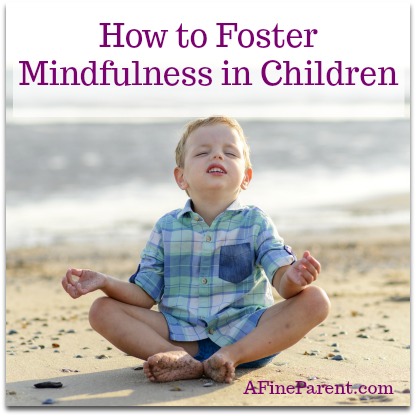 The term “mindfulness” is popping up everywhere these days. There are books and apps and whole pages dedicated to mindful moments in popular magazines. There are mindfulness exercises to help us slow down, eat less and lose weight, focus more, and work harder.
The term “mindfulness” is popping up everywhere these days. There are books and apps and whole pages dedicated to mindful moments in popular magazines. There are mindfulness exercises to help us slow down, eat less and lose weight, focus more, and work harder.
There’s even mindfulness activities that promise to help us be better parents.
I’ll admit it, I’ve bought in.
Mindfulness has been wonderful for me. It started slowly, years ago when I began taking yoga classes, in a tiny studio with only three other students and a teacher who had trained for hundreds and hundreds of hours.
These classes slowed my mind and I learned to observe the stories constantly running through it, without judgement or action.
Now, I’m by no means someone who sits and meditates for an hour everyday — there just isn’t time! Let’s be honest, some days…okay most days…I can’t even find just 10 minutes to sit quietly, let alone a whole hour!
But, still, the lessons I’ve learned in mindfulness are always quietly running through my head. They help me to be more present, calmer, and empathetic with those around me, especially with my child.
I’m not the only one who has seen the benefits of mindfulness. Researchers have published studies that compare brain images of those who regularly practice mindfulness and those who don’t.
These studies have found that those engaged in mindfulness activities have an increased brain capacity for decision-making, rational thinking, emotion regulation, learning, memory, kindness and compassion.
These studies also show that mindfulness practices decrease brain activity in areas involved with anxiety, worry and impulsiveness.
If studies done with adults show all these benefits, I couldn’t help but wonder if similar impacts would be seen in children. Here’s what I found out.
Mindfulness in Children
It turns out that mindfulness is quite useful for children, but it looks a lot different than it does for adults. In fact, it needs to look a lot different because children aren’t developmentally ready for the complex focus and level of awareness that adult mindfulness requires.
Mindfulness programs for children are becoming quite popular in schools around the world and studies are consistently demonstrating that these programs work. They don’t guarantee higher grades, but they have been shown to improve psychological, social and physical well-being in children.
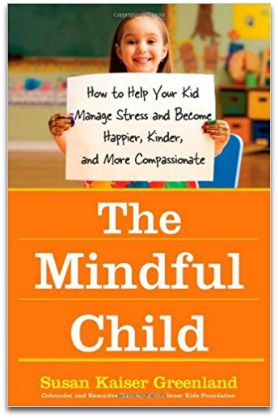 More practically, they are helping children improve their ability to sit still, pay attention and follow rules. Susan Kaiser Greenland, author of The Mindful Child, tells us that mindfulness programs are also helping children be kinder, more compassionate and more self-aware, which helps them get along better with others.
More practically, they are helping children improve their ability to sit still, pay attention and follow rules. Susan Kaiser Greenland, author of The Mindful Child, tells us that mindfulness programs are also helping children be kinder, more compassionate and more self-aware, which helps them get along better with others.
We’ve barely skimmed the surface of mindfulness with our toddler, but we are already seeing the effects. Mealtimes have been tricky for us from the beginning. He finds it hard to sit still and focus on eating, which often turns in to him running away mid-meal or even dumping his plate upside down. Anything to liven things up!
We’ve started using mindful eating techniques, such as naming the colors on our plate or discussing whether our food is crunchy or chewy. And all of a sudden, he’s more engaged in the meal, spending more time at the table, and even eating more of his food.
All of the benefits research is finding and those that we’ve already started to see with our toddler, make me think that mindfulness can help my child develop the confidence and skills he needs to succeed and be happy in life.
So what does mindfulness actually look like in children?
Mindfulness Activities for Kids
Now, anyone who has a toddler knows that you aren’t likely to get them to sit still and try to clear thoughts from their mind like adults do. They need activities to be more… well, active! The goal is to get them to start tuning into their bodies and their minds.
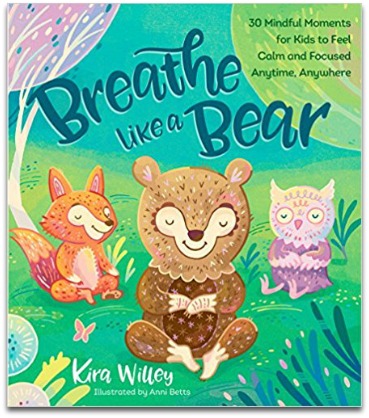 When I look for mindfulness activities for my son, I tend to gravitate toward books that he will enjoy reading too. Our favorites are Breathe like a Bear, by Kira Willey and Sitting Still Like a Frog, by Eline Snel. A quick Google or Pinterest search will bring up many more resources.
When I look for mindfulness activities for my son, I tend to gravitate toward books that he will enjoy reading too. Our favorites are Breathe like a Bear, by Kira Willey and Sitting Still Like a Frog, by Eline Snel. A quick Google or Pinterest search will bring up many more resources.
Here’s some of my go-to activities:
Explore your five senses
This is one of my favorites to pass the time when we’re waiting — be it in line at the grocery store, for our food in a restaurant, or for our turn at the doctor’s office. You can take turns naming what you see, hear, feel, smell, or taste. “I Spy” is a great game for focusing on things we see. It helps us be present in our environment, noticing things we may not have noticed otherwise.
Take a walk in nature
There’s so much good that comes from being outside. Kids love exploring and will naturally be more present in this environment. Go at your child’s pace, even if that means chasing a butterfly for 15 minutes or bending down to slowly watch a bug crawl along the ground.
Play “what’s the weather?”
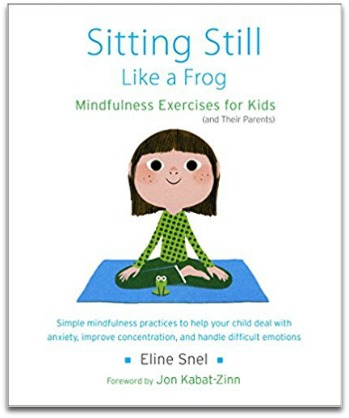 In Sitting Still Like a Frog, Eline Snel asks children to “summon the weather report that best describes [their] feelings at the moment”. Kids can say sunny, rainy, stormy, calm, windy, or anything that comes to mind. This activity is great because it keeps things simple, helping them to observe how they are feeling without getting too deep into specific emotions.
In Sitting Still Like a Frog, Eline Snel asks children to “summon the weather report that best describes [their] feelings at the moment”. Kids can say sunny, rainy, stormy, calm, windy, or anything that comes to mind. This activity is great because it keeps things simple, helping them to observe how they are feeling without getting too deep into specific emotions.
Do some yoga
Yoga is a fun way for kids to get in touch with their bodies and make connections with their minds. Practices for kids often involve poses that have them mimicking their favorite animals.
Yoga also teaching them breathing techniques that can help in times of stress. If you don’t have a yoga studio near you, the Storyland Yoga DVD has kids become different animals and plants through poses, and is really fun.
Have a dance party
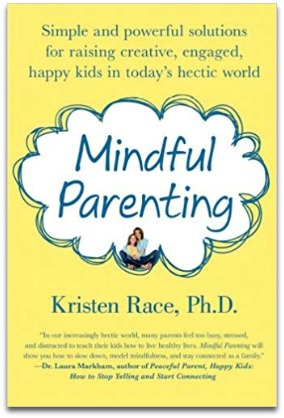 This is as simple and fun as it sounds. Turn down the lights, turn up the music and dance around the room. As Kristen Race, author of Mindful Parenting, puts it “we are typically present when we are dancing.” Letting go for a few minutes can help change our perspective and put a smile on our face. We keep a playlist of all our favorite dancing songs ready for when we need a break from routine or some cheering up.
This is as simple and fun as it sounds. Turn down the lights, turn up the music and dance around the room. As Kristen Race, author of Mindful Parenting, puts it “we are typically present when we are dancing.” Letting go for a few minutes can help change our perspective and put a smile on our face. We keep a playlist of all our favorite dancing songs ready for when we need a break from routine or some cheering up.
Taming Tantrums with Mindfulness
I’ll admit, the biggest draw to teaching my son mindfulness was the possibility of taming tantrums and calming meltdowns. While cultivating mindfulness in children can give both the child and the parent tools to return to calm, mindfulness needs to be practiced outside of tense situations in order to be effective.
When we are upset and our fight or flight responses are activated, our capacity to take in new things is very limited. Doing little things every day, such as the activities listed above, help to make mindfulness a habit, making it easier to draw on in moments of stress.
When a stressful moment arises, here are a few mindfulness techniques to help restore calm:
Notice and name body sensations, thoughts and emotions
Helping a child put words to big feelings and emotions helps them better understand why they are suddenly feeling so intense or unsettled.
With my toddler, I often do this for him, asking if he has butterflies in his stomach when he trips and falls. It’s remarkable how quickly naming the sensations he’s feeling helps him calm down. As he gets older, he’ll be able to start recognizing and naming what he feels on his own.
Calm jars
This is something our daycare uses with the kids when they’re having a hard time and just need a few moments before getting back to playing. It’s a small jar filled with water, glitter and some food coloring (there are tons of “how-tos” on Pinterest!).
The kids turn it over in their hands, watching the glitter slowly fall to the bottom. It gives them a few minutes to breathe and focus and come back to themselves.
Calming hug
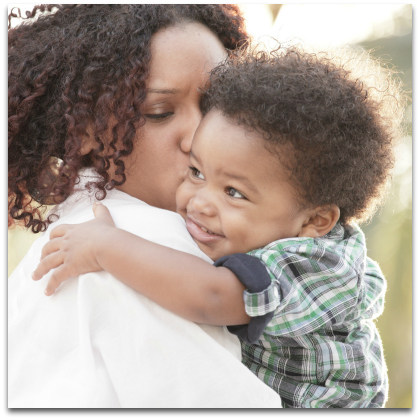 Sharing a hug while taking a few deep and deliberate breaths gives your child a place to feel safe and counting breaths helps to de-escalate the intensity of emotions associated with a particular situation. Once you’ve connected and calmed down a little, any challenge is easier to handle.
Sharing a hug while taking a few deep and deliberate breaths gives your child a place to feel safe and counting breaths helps to de-escalate the intensity of emotions associated with a particular situation. Once you’ve connected and calmed down a little, any challenge is easier to handle.
But I’ve learned another secret! Using mindfulness activities to tame tantrums often helps the parent more than child!
It’s like Dr. Laura Markham of Aha Parenting says, “You [the parent] always have the power to calm the storm, or to inflame it.” If you can use these mindfulness techniques to calm yourself, your response will be more intentional and more productive.
Take for example, the calming hug, it benefits both the parent and the child. It gives the child a safe space to calm down and it gives you, the parent, a moment to regroup before responding. This allows you to react in the way you want to rather than saying something you might regret later.
Since I’ve started engaging in mindfulness activities with my two year old, I’ve noticed that in trying to help him, I’ve also learned how to name my own emotions and recognize the sensations in my body. This has worked wonders for me and my adult relationships, too.
Not only am I helping myself be the positive parent that I want to be, but by modelling mindful behavior I can help my son to see the process in action and learn coping strategies that are effective and healthy, making him more resilient, compassionate and confident.
2-Minute Action Plan for Fine Parents
Think about the last few times you dealt with an upset child. What went well? What could have gone better?
Mentally prepare yourself for the next moment of tension. Pick a quick strategy to tame tantrums with mindfulness and be ready to practice it next time the opportunity arises.
For example, imagine counting to 10 with your child, modelling slow intentional breaths. My son loves to count to 10 and then roar like an angry dinosaur when he’s feeling frustrated or angry. The roars typically turn to laughter pretty quickly.
Ongoing Action Plan for Fine Parents
Over the next week, head to your local library or check Amazon for a book on mindfulness for kids. There are so many options!
Our go-to is Breathe like a Bear, by Kira Willey. Read through it with your child and start practicing the exercises. Many of them are quick and simple and great things to do when you find yourself with a few extra moments.
Remember, practicing in times of calm is the easiest way to call upon mindfulness to help during the tougher times.
How do you deal with the conflict between two children! My daughter is 8 her friend’s sister is 5 and she’s always doing things like rolling her eyes at my daughter, won’t speak when spoken to. She also tells my daughter she’s not worthy to play with certain toys. She will stand in her way trying to not let her pass by or puts her foot out to try and trip my child. When my child tells the parent they become upset saying ” you need to quit tattling on her”. Which leads to my child feeling bad. What do I do, help, please
Oh goodness, Cassundra! I’m sorry to hear your daughter is having a hard time with her friend’s sister. My experience with kids is really with the toddler age group and those friend issues seem a little easier to solve, but I can try to suggest a few things.
This situation is likely not about your daughter very much at all and is more about the sister (perhaps she’s upset that her sister is playing with someone else instead of her?), but I understand it’s still difficult. What’s tough about it is that you can’t control what the friend’s sister is doing or how the parents react (although I suppose you could have a chat with them about how it’s making your daughter feel), but you can help your daughter to build some resilience for these moments and mindfulness is a great tool to do that!
The naming emotions and body sensations technique described in the article could be useful. I also think that coming up with a little mantra she can repeat to herself to remind her the behavior isn’t about her and to draw on inner strength might help her when she’s feeling upset in the moment.
When I was trying to think of how to respond to your comment, I found an article on Psychology Today (linked below) about the Buddhist response to bullying and it really summed up what I was thinking. It has some suggestions on a mantra as well. I hope it’s helpful!
https://www.psychologytoday.com/ca/blog/creative-development/201007/the-buddhist-answer-bullies
I like the idea of teaching my children mindfulness and I think I am going to work on it a little this week with my 4-year old since he is home with me during the day. I think we all need a breather in this fast paced life of ours and the benefits are plenty! Many adults starting therapy start out having to learn what emotions they are feeling and give a name to them/ notice them and it is a hard exercise for many. If you can learn this when you are young, you can use the skill your entire life.
I agree Sarah! When I set out to start teaching my little guy to name his emotions, I quickly realized that I could barely do it for myself. As I’ve been working with him I have gotten much better at it and I see so many benefits from it. I can also see how useful a tool it would have been when I was younger!
Have fun working on mindfulness with your 4 year old – I think that’d be such a fun age for some of these activities!
Beautifully written Ashley! Love your incredible list of resources & how you have incorporated so many of the ideas into your own life and that of your son. Thanks!
Thanks Clare! I’m glad you enjoyed the article.
This is primarily driving to making the child relaxed and having a fine time as well.
I love the walking in nature season.
It does help! Being outside in nature is my favourite too!
I taught my kids (now 6 1/2) to growl or roar to share their big emotions when they were Toddlers. Its quite frightening in action! Now, I can’t seem to stop them from growling, while I expect them to be able to name their feelings. How do I turn growling into words?
Thank you
This is such an interesting perspective Rita! My little guy is still so little, I hadn’t thought much about how to transition the roaring into something else down the road. I feel like perhaps there is still a place for growling or roaring sometimes — it’s such a good release, but as we get older it does become less socially acceptable to be doing that in public.
Maybe it would be helpful to work with your kids to pick a new strategy that they can use in place of growling and then practice it in happier moments when they aren’t angry so that they are ready to use it when they are! Perhaps a new word to describe their feelings. I like to refer to “anger bubbles bubbling up” when I’m feeling angry or frustrated and then they could take a few moments and breathe deeply while imaging those bubbles popping. It might help give them a moment to let the anger calm down a little so they can address it more productively.
Some of the books mentioned in the article (Sitting Still like a Frog or Breathe Like a Bear) are full of great activities for kids that might help you find the right strategy for transitioning your kids to something new. Good luck! And feel free to comment back here, I’d love to know what you try and how it works.
Thanks for this article and the resources! So many helpful tips that make mindfulness accessible for every day parenting. I especially like the counting to 10 and roaring like a dino strategy.
How do you teach Mindfulness to a twelve years old Boy ?
Thanks for reading Mounir! Teaching mindfulness to a 12 year old is a little bit different than a toddler or younger child. As kids get older their mindfulness practice can start to look similar to adults, but some of the activities still apply. Nature is great for all of us and dance parties are always fun too. I know older kids can really enjoy guided body scans as well, to help them relax and connect their mind to their body.
For further reading, there are lots of great resources out there! The Mindful Parenting book by Kristen Race, mentioned in the article covers older kids and a quick search for “mindfulness for teens” will bring up even more. Good luck!
Thanks Alicia! I’m so glad it was helpful.